
Exhibition Time: October 30 to November 7, 2020
Exhibition Location: Exhibition Hall 1-11 of National Art Museum of China
Organized by:
National Art Museum of China
Hubei Provincial Department of Education
Hubei Provincial Department of Culture and Tourism
Hubei Provincial Federation of Literary and Art Circles
Hubei Institute of Fine Arts
Exhibition Profile:
In 2020, Hubei Institute of Fine Arts will celebrate its centenary. Its century-old path of running has witnessed the gestation and development of modern art education in China, as well as the great process of the Chinese nation’s awakening from thedegradation to cultural salvation and then to cultural confidence.
In order to carry out the instructions of General Secretary Xi Jinping to thehigher education offine arts: “To cultivate students with great love, and to create works with great arts”,which emphasizes the promotion of thespirit of Chinese aesthetic education and the cultivation of new talents ofthetimes, the“Century Aesthetic Education – Art Literature Exhibition of the 100th Anniversary of Hubei Institute of Fine Arts” aims to demonstratethe thinking, exploration and achievements of efforts on the path of aesthetic educationin the pastonehundred years, to comprehensively displaythe solid footprints oftheconstruction and development ofauniversity with“history,characteristics andcontribution” in the past hundred years, to showtheoverall developmentsituationof art creation and art education of Hubei over the past 100 years,andto reflect the responsibility and accountability of HIFA in the new era of developing socialism with Chinese characteristics.
Exhibition Preface:
HubeiIsstillA Land ofRomance
- Exhibition Preface of HIFA
The land of Chu, where Hubei Province stands today, was the place where Chinese ancestors dwelled where the wisdom of the sages originated, and where loyalty and affection was brewed. Here, Emperor Shennong tastedhundreds of herbs and taught the people to cultivate the land; LaoziandZhuangzi’s Taoismthat emphasizes the unity of man and heavenflourished;Qu Yuan sang the Songs of Chu and Lisao full of his love for and loyalty to thehomeland. In modern times, the Wuchang First Uprising of the 1911 Revolution, the “February 7th” Strike, the lectures given at the Central Peasant Movement Training Institute, the “August 7th” Conference, theHuangma Uprising, the Battle of Wuhan that defended the city in 1938, the Breakout on the Central Plains, and a series ofotherrevolutionary activities and deeds took place here. Today, Hubei, theland of heroes which defeated the epidemic, has become the epitome of the endurance, charisma, cohesion, execution, responsibility, and mission of the Chinese nation in the face of drastic changes, and is admired and respected by the world. HubeiInstituteof Fine Arts was born in this land full of wisdom, affection and tenacity.
In 1920, the Wuchang Fine Arts School founded by Jiang Lanpu, Tang Yijing and Xu Ziheng was the starting point for HubeiInstitute of Fine Arts. Mr. Jiang Lanpu participated in the Wuchang Uprising, Mr. Tang Yijing actively participated in the “May 4th” Patriotic Movement and the New Culture Movement,while Mr. Xu Ziheng worked as a secretary of Hubei Education Association to educate and save the country. It can be seen that this century-old school has shouldered the mission of revitalizing the nation, rejuvenating culture, and prospering art from the very beginning.In addition, the red revolutionary culture also penetratesintothe veins of the school, setting its bright background. In the era of wars, the school tossed around many places, encountered various difficulties andhardships, but still persisted. After the founding ofthe PRC, although the school had undergone changesof division and integration, it has kept running. In the spring breeze of reform and opening up, this prestigious school with profound background has blossomed with new life: various artistic thoughtshave been turbulent, diverse aesthetic styles have reinforcedeach other, new views on art theory and new patterns of artistic creation have emerged oneafter one, and artistic design achievementshave beenwidely used bythesociety and playing an active role in improving the aesthetic quality of life and economic development. Looking back at the history of the school, famous teachers, artists, artworks, writings, and alumni have not only promoted the school to the high ground of art education in Central China, but also exerted extensive influence across the country. Pieces of outstanding Chinese paintings, oil paintings and comicbooks expressing socialist construction,extolling heroes and model workers, and complimenting history and natural scenery fully reflect the creative enthusiasm of the teachers and students ofHIFA who go deep into life and take root in people. Many works have also been collected by the National Art Museum of China, becoming shining coordinate points for the development of Chinese art. Today, under the guidance of Xi Jinping’s thoughts on socialism with Chinese characteristics in the new era, the school strengthens cultural self-confidence, adheres to the Chinese cultural standpoint, adheres to the leadership of socialist core values, fully implements the party’s educational policy, highlights the running characteristics, and improves students’ aesthetic and humanistic qualities,aiming to turn morality, wisdom, and knowledge into a stream of water into the lives of students, encourage students to establish goals based on faith, generatewarmth with feelings, and build their muscles with responsibility, integrate patriotism into the soul, and express ideals and sentiments with works.
Over the past 100 years,HIFA has beenenduring great hardships and upholding an inclusive open mind, patriotic loyalty, aggressive attitude toward self-improvement, and the spirit of innovation to open up a vast world. Here, Chinese culture and Western culture blend for heterogeneous dialogue, artis combined withreal applications, creation meets social needs,andscience, reason, passion and imagination coexist harmoniously with differences. Over the past century, HIFA has witnessed andbeen involvedin the development andtransition of Chinese modern art education and art creation, and has cultivated a large number of outstanding artists, designers, theorists and critics for the country, nation and people. They have usedpaintingbrushes, gravers,ideas and texts to create a large number of wonderful works fornational liberation, socialist construction,andthe reform and opening up of the country. In the future, HIFA will continue to follow the laws of aesthetic education, promote the spirit of Chinese aesthetic education, and rely on fine arts to strengthen moral education, cultivate talents, uphold kindness, enlighten authenticity,nurture the nature, delight the feelings, govern the language and guide behavior with fine arts, cultivate more outstanding talents,and embrace greater enthusiasm for life, warmth to the people, affection for the country and passion for creation, and create more thoughtful, exquisite and well-made works!
In this fall, HIFA and the National Art Museum of China co-organizedthe “Century Aesthetic Education– Art Literature Exhibition of the 100th Anniversary of Hubei Institute of Fine Arts” in China’smost superior palace of fine arts, aiming to let the audience feel theforms of beauty creationin different social environments, the presentation of the essence of beauty in different historical stages,andthe development of the concepts and methods of art education in the social process……
The rhymes of the songs of Chu and the theories of Laozi and Zhuangzi have beenfar away, but the patriotic gene is deeply rooted in the soul, and the spirit of seeking is constantly carried forward. Over a hundred years of vicissitudes and a hundred years of education, today, in the prosperous age, the great dream of national rejuvenation endows beauty and aesthetic education with the value of the new era. The people ofHIFA will continue to pursue truth, goodness and beauty unremittingly, and write a new chapter of virtues and souls! The National Art Museum of China, which takes the spread of beauty as its mission, is obliged to support it. To support art education in schools is to support the development of China’s futurefinearts undertaking.
We firmly believe that HIFA bathed in the light ofthe new era will take 100 years of experience, success and glory as a new starting point and move towards a more brilliant tomorrow!
Wu Weishan, Curator of the National Art Museum of China
October 2020
Exhibition Preface:
A Hundred Years Is Just In The Prime of Life
On theoccasion of 2020,we look back atthe pastwe have experienced - from the establishment of WuchangFineArts School by Jiang Lanpu, Tang Yijing and Xu Ziheng in 1920, to the Private Wuchang ArtAcademy, through Zhongyuan University School of Art and Central South ArtCollege, Central SouthFine ArtsAcademy,Department of Art ofHubeiCollegeof Education, Department ofPaintingand Graphics of Central China NormalCollege, Hubei Institute of Art, and to Hubei Institute of Fine Arts whichwas independently established in 1985, a century has passed. Through the vicissitudes of the century, we have been determined, persevering, and working hard to run the school, and cultivated generations of outstanding art talents who “respect morality, study hard,act agilely, andaim forbeauty”.
“Carry on the past and open up the dream of aesthetic education, anduphold the belief to servethe country”. Duringthe century, we have taken “promoting aesthetic education” as our mission, shared the destiny with the motherland and people andkept abreast of the times and society. On the wayof art pursuit, Xu Dungu, Guan Liang, Tang Yihe, Zhang Zhaoming, Wang Xiazhou, Guan Yuke, Wen Yiduo and other great predecessorsdid not forgetto “assume responsibilities with iron will” whilepainting. While calling for saving the country, they persisted on artistic creation and theoretical research,andcompleted the self-transformation of modern art language with a sober sense of national crisis and mission as an opportunity, and deeply planted the roots of patriotism, aesthetic education, and culture in the land of China. In thetough years of post-war reconstruction, we forged and inherited the “inclusive” academic spirit and the “compatible and interactive” teaching philosophy, and gathered well-known artists, art historians and educators including Zhang Zhenduo, Tang Wenxuan, Yang Liguang, Liu Yiwen, Ruan Pu, Shi Qun, Chen Tianran, Zhang Zuwu, Liu Zhengde, Li Yifu and Zhang Lang, andinherited the thoughts and creative traditionof focusing on social reality, and cultivated talents from all over the world. For a time,talents were likestars shining on the land of China.With grand and broad cultural vision and passion, in the spring after thePRC was founded, a group of well-known artists have made their efforts to construct a contemporary image of Chinese culture in a new historical context through the dialogue between individuals and the times, and the dialogue between Eastern culture and Western culture, so as to achieve the unity of the times, the country and individuals with different themes and in different artistic forms. Art historians take the development of local plastic art andfinearts theory as the starting point for their research, and have created a modernfinearts history research system, laying a solid theoretical foundation for the improvement of the discipline system of art. Many outstanding designers combine art with production and life, use beauty to awaken people’s pursuit and yearning for a better life, and integrated cultural heritage into people’s daily lives.
“A century ofacademic veinhas been passed down from generation to generation, and the original aspiration remains unchanged.” Since entering the new century, we have adhered to cultural inheritance and missionassumption, and carried out teaching reforms in practice to advance with the times, pioneer and innovate, pay attention to the times, serve the society, let “art be integrated into life”, create urban public spaces and serve regional economic development, reshape the image of contemporary cities, expand the space for aesthetic education, and realize the humanistic value and social connotation of art. In the transition and connection of vivid teaching cases, excellent course documents, and design works with strong regional and cultural characteristics,time and time again we return to history and absorb the potential energy hidden in the depths of it. On the Tujia brocade that carries thousands of years of memory, on the beautiful red paper-cuts, and on the ancientqin with pine green and gold lacquer,we have seen the clash between inheritance and reform of Traditional Chinese handicrafts over the long period of time, and the interaction between classics and contemporary art.
Taking “designcapitalconstruction”, “urbanreconstruction”, “urbantransportationconstruction”, and “Two-Oriented Society” as different synchronic profiles, we delve into history and restore the cultural features ofvarious urban“homes” and let the history of Chu, beauties, and faith totems reappear in contemporary life; we search for memories and salvage the glamour of the city scattered in all corners of history, so that the images of cities canreshapetheir spiritual heritage and humanitytemperament in the alternate presentation of the past, present and future; we face the daily life, explore the poetic quality and interest of life, form a new knowledge production field in the daily life of the masses, and show the interactive relationship between art, people and society with an effective cultural landscape, making the development of art and cities finally achieve a sustainable state of “symbiosis”.
At the beginning of2020,theepidemic broke out and Wuhan waslocked down. During the epidemic prevention and control period, teachers and students ofHIFA actively fought against the epidemic with art, not only drawing the love of the world with thegreat art, but also united as one, donated money and materials, and bravely served as volunteers to fight the epidemic, provided and transported various urgently needed supplies for community residents and anti-epidemic frontline. The epic anti-epidemic stories, thevividheroic images, and the auras on the anti-epidemic medals are our practical actions to show the strength and spirit ofHIFA, demonstrating the lofty ambition of thefaculties and students ofHIFA tounify against the epidemic andtheirpatriotism ofhelping each other.
Looking back atthe past century,the piles of yellowed teachingsketches, precious historical photos, the youthful figures of the graduates, even letters, transcripts, anddiplomas seem to tell the world “what happened here” - this is not only the history of an art academy, but also the epitome of the changes in Chinese modern art education, and isparticularlyacore sitethat has been continuously promoting art education in the new era of China.
In this exhibition, from HubeiInstituteof Fine Arts to the National Art Museum of China, we review the 100-year history of aesthetic education. It is not only a remembrance and commemoration, but alsoa“torture”in faceof time and history, and gives solemn answers again and again.On the new historical journey, we will not forget the legacy of our ancestors, keep in mind the entrustment of the party and the country, carry forward the fine tradition of patriotism for the people, upholding morality and advocating arts,so as“to cultivate students with great love, and to create works with great arts”; adhere toestablishing virtuesand cultivating people, take root in the life of the times, follow the characteristics of aesthetic education, and promote the spirit of Chinese aesthetic education; follow the laws of modern art education, move toward the direction of high-level university construction, deepen teaching reform, and realize the integration of academic research, personality shapingand practice forging, promote the integration of “art” and “technique”, seek the unity of “laws” and “skills”,and strive to cultivate socialist builders and successors with all-round ability in areas such as morals, intelligence, physical fitness, work and aesthetics!
The past has passed, and our undertaking is still on the way. One hundred years is just in the prime of life. We firmly believe that the best commemoration of history is to create new history.
Xu Fen, Hubei Institute of Fine Arts
October 2020
Some Exhibits:

Co-painted FlowerAxis by Tang Yijing et al., late 1920s to mid-1930s, Chinese painting,142x30cm
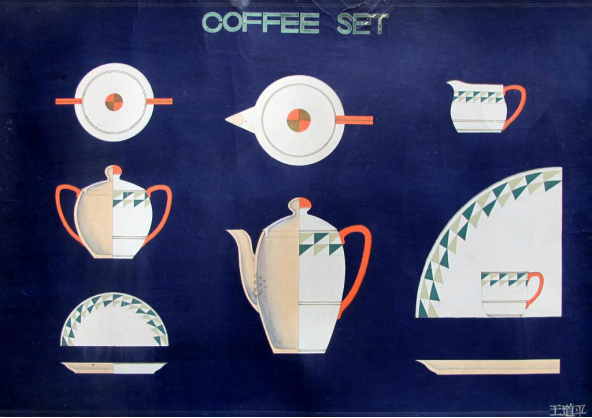
Coffee andTeaSetSeriesDesign by Wang Daoping, 1933-1936, paper painting,73.7x50.2cm
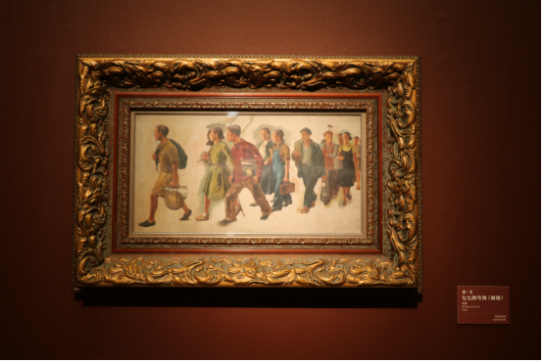
Qiqi’s Horn by Tang Yihe, 1941, oil painting,33.3x61.2cm

Grandpa and Grandson by Tang Yihe, 1943, oil painting, 84x65cm

Letter Holdingby Wang Xiazhou, 1949, Chinese painting, 78x46cm

ChineseTrumpetCreeper by Zhang Zhaoming, unknown year, Chinese painting, 97x49cm
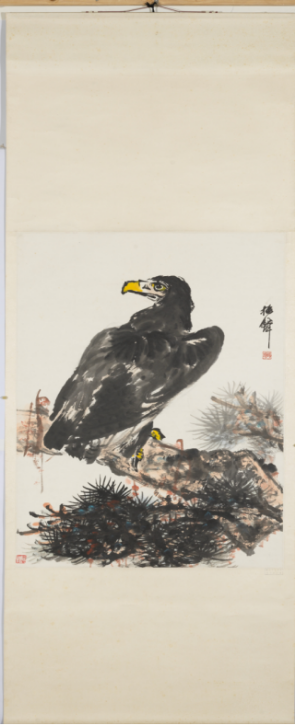
Eagle on Pine Tree by Zhang Zhenduo, unknown year, Chinese painting, 101x69cm
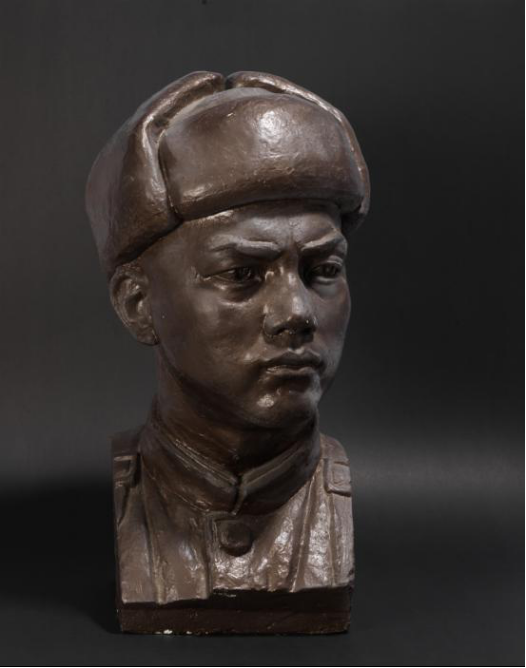
Portrait ofCPV by Zhang Zuwu, unknown year, sculpture,52x32x31cm
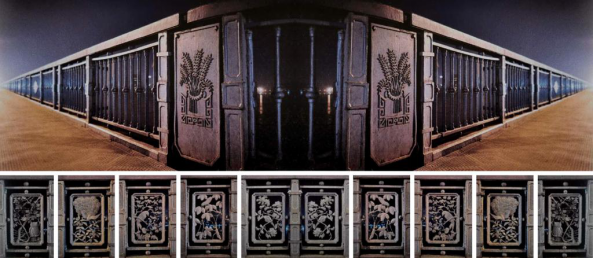
Railing Ornament ofWuhan Yangtze River Bridge by Li Yifu et al., 1950, stone sculpture,unknown size
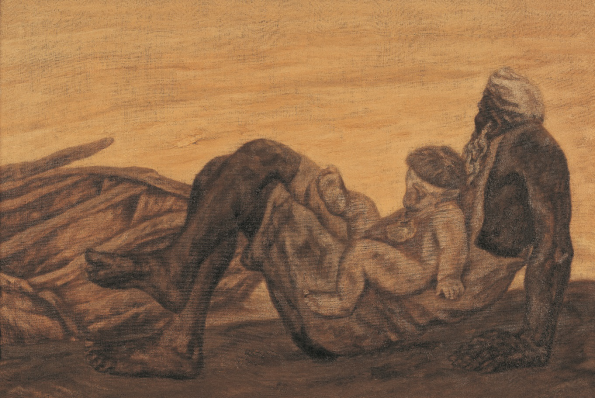
Grandpa’s River by Shang Yang, 1984, oil painting, 110.5x149.5cm
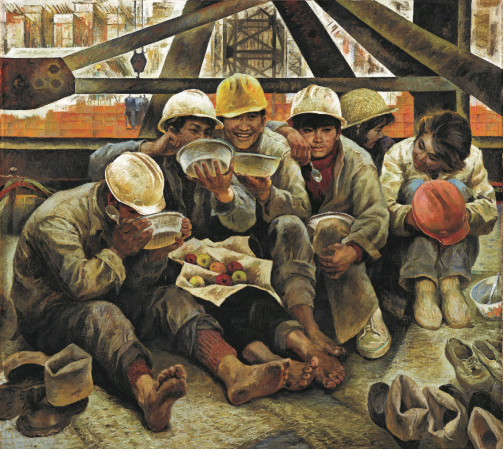
Children of the Dam by Tang Xiaohe and Cheng Li, 1984, oil on canvas, 140x157cm
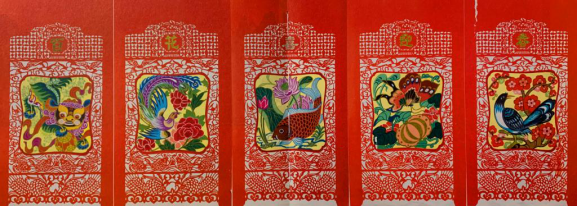
Flowers Celebrating Spring by Zhang Lang, 1980s,Paper cutting, 136x48.7cm

Red Peony by Xu Yongmin, 1998, Chinese painting,67x67cm
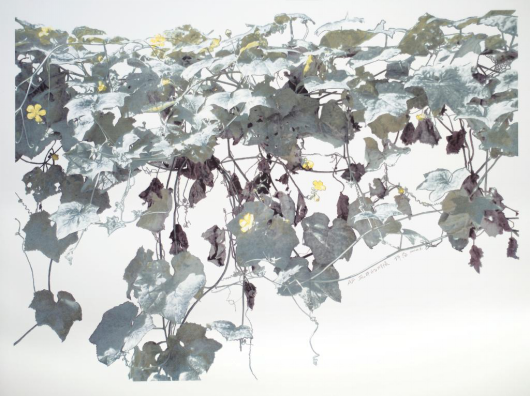
When Flowers Bloom by Xu Fen (A·P), 2014, print,90x120cm

Design of New Yellow Crane Tower by Chen Shun’an, unknown year, paper painting,49x60cm

“Stamp” Memories by Fan Hancheng, 2015, poster, 100×70cm

HumanUpperLimbRehabilitationMedicalRobotSeriesProductDesign by Li Liangjun, Huang Zhaohui and Zhu Jianhua, et al., 2010-2015, industrial design,1795cm×742cm×800cm
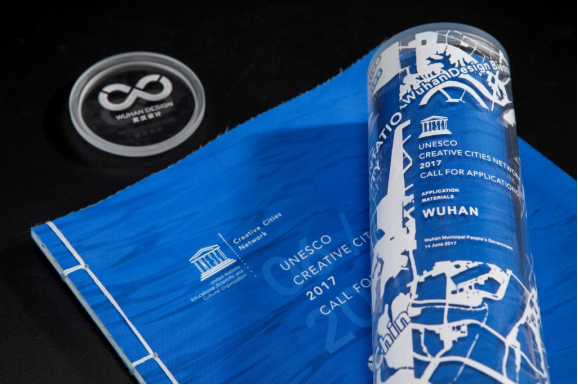
Wuhan World Design CapitalApplicationDesign by Yuan Xiaoshan, 2017, paper painting,210×285mm

Wax and Wane by Chen Yinan,2018, pottery and metal,70x30x200cm
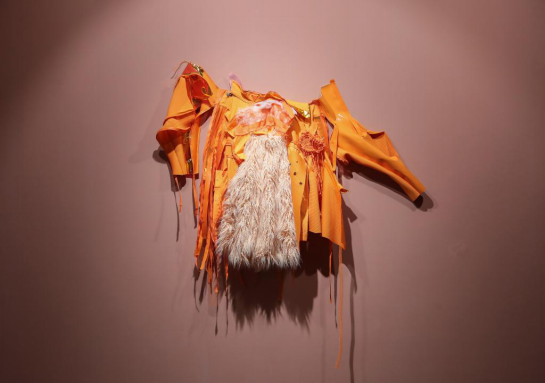
Orange by Li Haibing,2019, apparel design,120x70cm
Photo and information sources:Anniversary Office,Art Museum of Hubei Institute of Fine Arts